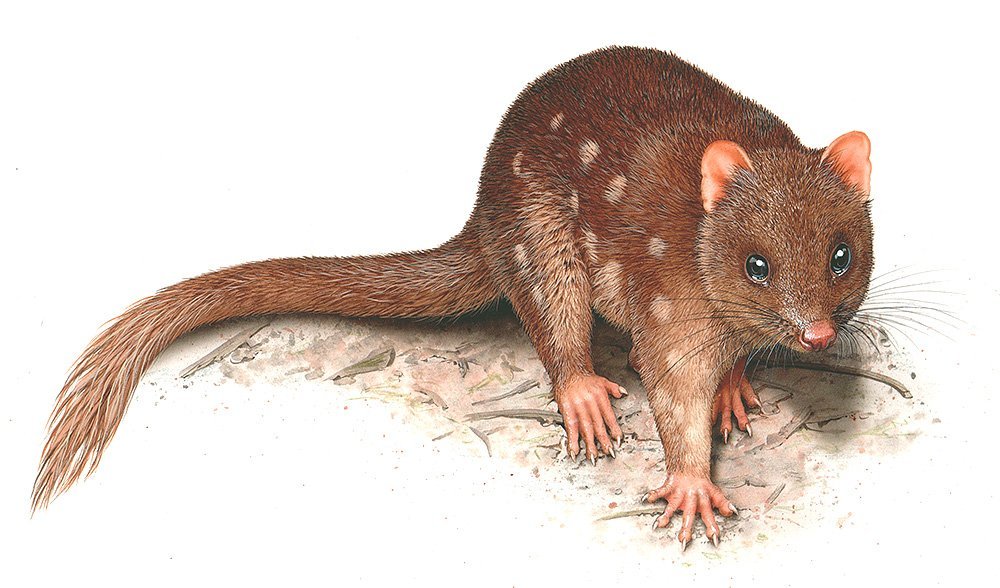A guide to all six species of quoll

Early settlers referred to quolls as ‘native polecats’, because of their resemblance to the European relative of the weasel, and today they are still sometimes called native cats.
Quolls are members of the Dasyuridae family, and are easily recognised by their pointed snout, long tail and ginger/brown or black fur with distinctive white spots. They have sharp teeth and strong jaws for tearing meat and crushing bones and invertebrates. Like the related Tasmanian devil, these fierce little marsupials communicate loudly with hisses and screams.
Once widely distributed across Australia and New Guinea, populations have shrunk due to habitat loss, disease and competition from introduced foxes and cats. Each of the six quoll species inhabits a distinct range: the northern quoll prefers tropical regions with high rainfall, the western quoll has adapted to the arid regions across the inland south-west, and the tiger and eastern quoll live only in mesic zones.
Quolls shelter in hollow logs or dens during the day, emerging mostly at night to hunt. The largest species, the tiger quoll, eats birds, reptiles and mammals such as bandicoots, possums and echidnas, while the smaller species eat mainly insects, birds, frogs, lizards, snakes, small mammals and fruit. Quolls are also known to eat carrion, and will scavenge around campsites and rubbish bins. Quolls are generally solitary, except during the breeding season and when they frequent unusual communal ‘latrines’ to mark territories and socialise.
1. Tiger quoll
Dasyurus maculatus

Illustration: Kevin Stead
Size: 2.5–4kg (male); 1.5–2.5kg (female)
IUCN status: Near threatened
Also known as the spotted- tailed quoll, the tiger quoll is the largest species. It can be distinguished by its reddish- brown fur, with white spots that continue down its bushy tail, differentiating it from other quolls. It is highly mobile – moving up to 3km in a night – and may also inhabit large territories.
2. Eastern quoll
Dasyurus viverrinus

Illustration: Kevin Stead
Size: 900g–1.9kg (male); 700g–1.1kg (female)
IUCN status: Endangered
The eastern quoll was once found across much of the south-eastern mainland, and as far as northern as NSW. The last members of the mainland population died out here in about 1963, but these quolls remain in Tasmania, where they inhabit rainforests and open grasslands, mainly in the eastern half of the state.
3. Northern quoll
Dasyurus hallucatus

Illustration: Kevin Stead
Size: 400–900g (male); 300–500g (female)
IUCN status: Endangered
The northern quoll is the smallest, but the most aggressive of the four Australian species. Once common across northern Australia, this species could be found from the Pilbara, WA, to south-eastern Queensland. The northern quoll now occurs only in five regional populations across QLD, the NT and WA.
4. Western quoll
Dasyurus geoffroii

Illustration: Kevin Stead
Size: 700g–2.2kg (male); 700g–1.1kg (female)
IUCN status: Near threatened
The western quoll, or ‘chuditch’, is WA’s largest marsupial carnivore. It once inhabited 70 per cent of the continent but remains only in the south-western corner of WA (and in an introduced population in SA’s Flinders Ranges). Easily confused with the eastern quoll, its first toe on the hind foot and a darker tail help to differentiate it.
5. New Guinea quoll
Dasyurus albopunctatus

Illustration: Kevin Stead
Size: 580–710g
IUCN status: Near threatened
The New Guinean quoll is widespread throughout much of Indonesia and Papua New Guinea, but has a patchy distribution across its range. Smaller and darker than the bronze quoll, this species feeds on a large range of prey, including birds, rats, other marsupials, small reptiles and insects.
6. Bronze quoll
Dasyurus spartacus

Illustration: Kevin Stead
Size: N/A
IUCN status: Near threatened
Endemic to New Guinea, the bronze quoll was first discovered in the early 1970s, and scientists thought it was an outlying population of the northern quoll. It wasn’t until 1987 that Dr Stephen Van Dyck recognised them as distinct. Little is known about this species and they may number just a few thousand.

